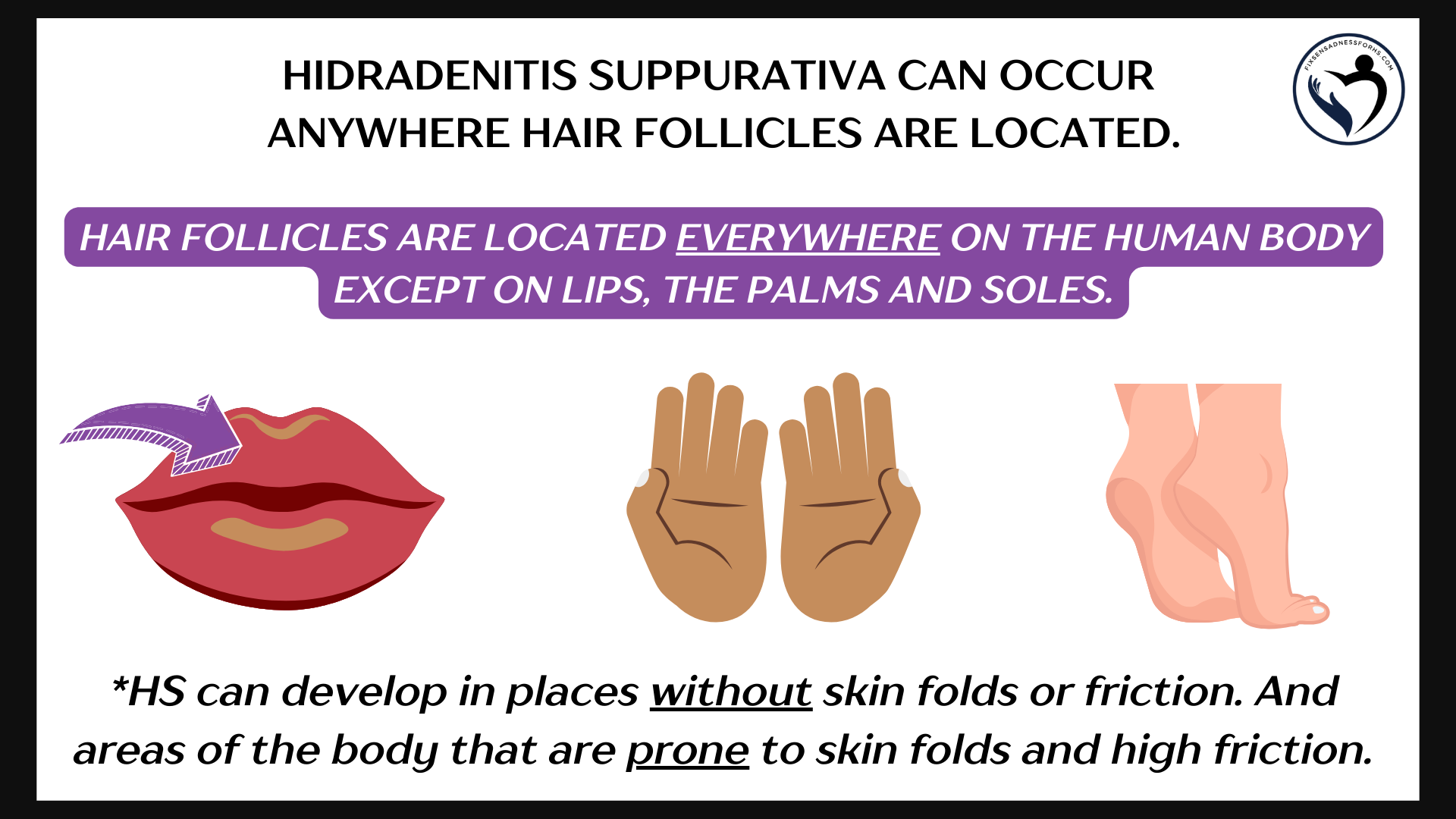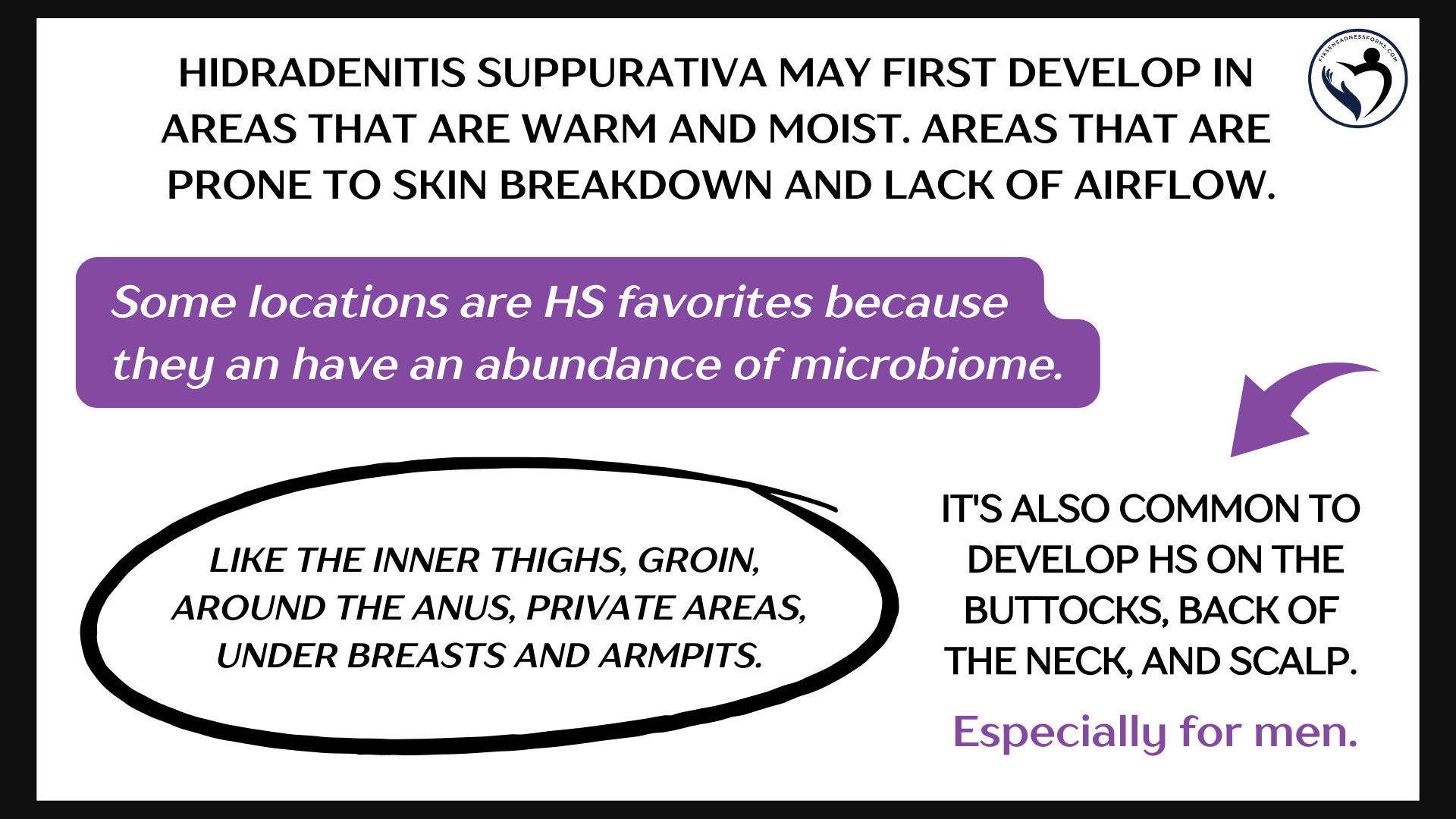What is Hidradenitis Suppurativa (HS)?

Hidradenitis Suppurativa is a non-contagious inflammatory illness that causes painful abscesses (boil-like), nodules underneath the skin, skin tunneling, and scarring (often extensive).
It is a complicated condition that cannot be simplified to only the skin, immune system, hair follicles, follicular occlusion, microbiome disturbance, or biofilm.
HS does not discriminate, nor is it rare. Millions of people around the world are afflicted. Individuals experience significant and widespread effects on their physical, mental, social, emotional, spiritual, and financial well-being.
Like many illnesses, the exact cause (s) remain unknown. It has been established for more than ten years that HS is a chronic inflammatory illness, with involvement of follicular occlusion, microbiome, and biofilm.
HS can exhibit a wide range of clinical presentations, with variations in appearance, characteristics, and sizes. Although HS can sometimes appear as small bumps or acne-like lesions, it is not always the situation. In reality, abscesses can expand to the size of a cantaloupe or beyond.
HS doesn’t always begin as an abscess (boil-like). It might begin as a DEP (blackhead-like), a pustule (pimple-pimple-like), or a nodule (beneath the skin’s surface), then become inflamed. Some HS "bumps" remain underneath the skin without coming to the surface.
This topic requires increased awareness.
Hidradenitis has the potential to develop in any region hair follicles are present, despite hair growth. With a few exceptions, abscesses (“boil-like”) and nodules can manifest in any area of the body, excluding ON the lips, palms of hands, and soles of feet.


It is possible for HS to occur in the ears and in the nose. HS cannot be developed internally within the body (on organs, intestines, etc.).
HS has three stages (III) using the Hurley staging system

You can have various Hurley stages (I, II, III) on different areas of the body. See more on this topic in the related section below.
Some Facts:
The classification of HS as a gland disease was debunked years ago. However, glands can be bystanders in the process and they can be affected. But not the primary driver.
Antibiotics are primarily prescribed for their anti-inflammatory properties unless there is an infection present. If an infection occurs, it is considered a secondary complication.
Having other illnesses or comorbidities does not alter the classification of HS.
Hidradenitis Suppurativa affects individuals of all ages, races, sexual orientations, beliefs, disabilities, blood types, sizes, shapes, and locations without discrimination.
It is not an infectious illness (not contagious)
What has been widely recognized for the past several years?
- HS meets the criteria for a chronic inflammatory illness that has been established. But its not that simple.
- Research has specifically provided evidence with HS for auto-inflammatory, the innate immune system, and its role in the immune system overreacting.
- HS has never been categorized as an autoimmune condition. Meaning there is no substantial, long-standing research or pathology that fully meets the criteria. *Autoimmune is the adaptive immune system, where healthy tissues are mistakenly identified as foreign and are attacked.
Important to note: Research is always ongoing. The complexity of the immune system is truly extraordinary. Our bodies and HS exhibit a great deal of complexity. Experts may find out there is a place for both auto-inflammatory and autoimmune as they do share common features, but for now, chronic inflammatory illness, with follicular occlusion involvement, along with microbiome and biofilm components, is what long-standing research & pathology support.
Special Note: Researched, compiled, and written by Denise Fixsen. This information is backed by my 46 years of living with Hidradenitis Suppurativa, 10 years of dealing with multiple chronic illnesses, 36 years of advocacy, and continuous education. And to ensure accuracy, reliability, and trustworthiness, I incorporate peer-reviewed studies and other high-quality sources into my articles and material. I also wanted to inform you that I’ve chosen to end my collaboration with editors on my articles. Although there may be grammar errors due to brain illnesses (mostly), with this said, my content remains reliable, factual, and solid.
Medical Disclaimer: This content is solely for information, education, and support. The purpose is not to serve as a replacement for professional medical advice, diagnosis, or treatments.
Sources: PMC7450471, PMID:32884675, doi:10.1001/jamadermatol.2017.0904, doi.org/10.1016/j.clindermatol.2023.08.021, PMC8537933, PMID:34696185, PMC8324042,doi.org/10.1186/s43162-021-00040-5
FAQ posted on 08-27-2024
